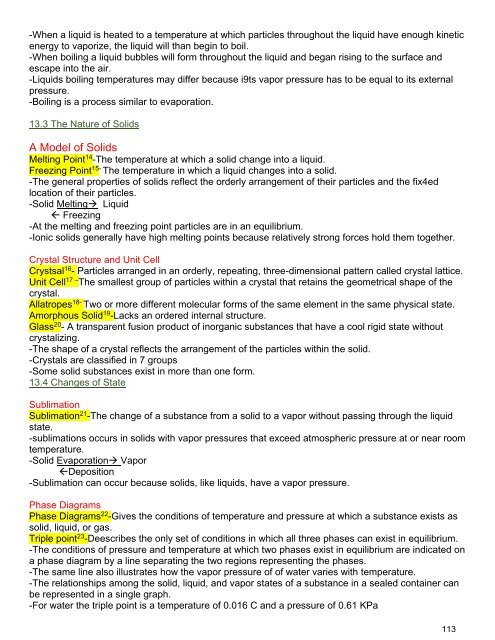Create successful ePaper yourself
Turn your PDF publications into a flip-book with our unique Google optimized e-Paper software.
-When a liquid is heated to a temperature at which particles throughout the liquid have enough kinetic<br />
energy to vaporize, the liquid will than begin to boil.<br />
-When boiling a liquid bubbles will form throughout the liquid and began rising to the surface and<br />
escape into the air.<br />
-Liquids boiling temperatures may differ because i9ts vapor pressure has to be equal to its external<br />
pressure.<br />
-Boiling is a process similar to evaporation.<br />
13.3 The Nature of Solids<br />
A Model of Solids<br />
Melting Point 14 -The temperature at which a solid change into a liquid.<br />
Freezing Point 15- The temperature in which a liquid changes into a solid.<br />
-The general properties of solids reflect the orderly arrangement of their particles and the fix4ed<br />
location of their particles.<br />
-Solid Melting Liquid<br />
Freezing<br />
-At the melting and freezing point particles are in an equilibrium.<br />
-Ionic solids generally have high melting points because relatively strong forces hold them together.<br />
Crystal Structure and Unit Cell<br />
Crystsal 16 - Particles arranged in an orderly, repeating, three-dimensional pattern called crystal lattice.<br />
Unit Cell 17 – The smallest group of particles within a crystal that retains the geometrical shape of the<br />
crystal.<br />
Allatropes 18- Two or more different molecular forms of the same element in the same physical state.<br />
Amorphous Solid 19 -Lacks an ordered internal structure.<br />
Glass 20 - A transparent fusion product of inorganic substances that have a cool rigid state without<br />
crystalizing.<br />
-The shape of a crystal reflects the arrangement of the particles within the solid.<br />
-Crystals are classified in 7 groups<br />
-Some solid substances exist in more than one form.<br />
13.4 Changes of State<br />
Sublimation<br />
Sublimation 21 -The change of a substance from a solid to a vapor without passing through the liquid<br />
state.<br />
-sublimations occurs in solids with vapor pressures that exceed atmospheric pressure at or near room<br />
temperature.<br />
-Solid Evaporation Vapor<br />
Deposition<br />
-Sublimation can occur because solids, like liquids, have a vapor pressure.<br />
Phase Diagrams<br />
Phase Diagrams 22 -Gives the conditions of temperature and pressure at which a substance exists as<br />
solid, liquid, or gas.<br />
Triple point 23 -Deescribes the only set of conditions in which all three phases can exist in equilibrium.<br />
-The conditions of pressure and temperature at which two phases exist in equilibrium are indicated on<br />
a phase diagram by a line separating the two regions representing the phases.<br />
-The same line also illustrates how the vapor pressure of of water varies with temperature.<br />
-The relationships among the solid, liquid, and vapor states of a substance in a sealed container can<br />
be represented in a single graph.<br />
-For water the triple point is a temperature of 0.016 C and a pressure of 0.61 KPa<br />
113



